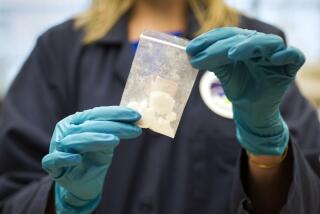Probe focuses on heparin sources
- Share via
WASHINGTON — The investigation into a blood thinner suspected in some 19 U.S. deaths is now focusing on the possibility that raw biological ingredients were contaminated even before they reached a factory in China, manufacturer Baxter Healthcare Corp. said Friday.
That raises the prospect that the problem could have occurred somewhere along a supply chain that includes layers of middlemen and originates in pig farms. Heparin, a generic medication, is derived from a substance in the lining of pig intestines. The drug is widely used to prevent blood clots from forming during kidney dialysis and cardiac surgery.
The case has reinforced concerns about the quality of Chinese products. But unlike last year’s pet food recall, it was frail patients who suffered the ill-effects of the drug contamination. Nearly 800 patients suffered severe allergic reactions, some life-threatening.
The Food and Drug Administration on Friday announced new testing requirements for all imported heparin. Manufacturers must agree in advance to undertake sophisticated tests or their shipments will be held at ports of entry for government testing.
FDA officials said they are close to identifying the mysterious look-alike ingredient that contaminated the Baxter heparin and prompted a recall last month. The substance, which acts much like heparin, could not be detected with conventional tests for drug purity and potency.
Once the contaminant is identified, investigators should be able to tell more about whether it was deliberately added or occurred naturally, or as a result of some problem with processing, FDA Deputy Commissioner Janet Woodcock said.
“We are very close,” she said. “When we complete that, [it] will help our understanding of how it got in.”
However, pinpointing the source may not be possible if the contamination occurred along the chain of farmers and middlemen who handle the material in China, where the FDA’s regulatory reach does not extend and where manufacturing standards have been called into question.
FDA officials said they have visited some of the middlemen -- called “consolidators” -- to discuss the quality of materials received from slaughterhouses. Consolidators refine the material and prepare it for shipping to a pharmaceutical facility in Changzhou. FDA officials said they are trying to arrange with Chinese authorities for additional inspections of the supply chain.
The Illinois-based Baxter said in a news release that the focus of the investigation had turned to the supply chain and to scientifically proving that the contaminant caused the allergic reactions seen in U.S. patients.
“There are three key questions that we are trying to answer,” said Norbert G. Riedel, Baxter’s chief scientist. “What exactly is the contaminant, where in the supply chain was it introduced, and can we prove that this contaminant is in fact causing the reactions we’ve seen?”
China is the world’s leading producer of heparin. Baxter’s supplier, Wisconsin-based Scientific Protein Laboratories, is a joint venture partner in the Changzhou facility that produced the tainted heparin.
The FDA failed to inspect the Chinese plant before it started shipping heparin to this country because someone at the agency mixed up the name of the facility with one that had already been inspected.
--
ricardo.alonso-zaldivar@latimes.com
More to Read
Sign up for Essential California
The most important California stories and recommendations in your inbox every morning.
You may occasionally receive promotional content from the Los Angeles Times.












